FIAT PANDA 2018 Owner handbook (in English)
Manufacturer: FIAT, Model Year: 2018, Model line: PANDA, Model: FIAT PANDA 2018Pages: 228, PDF Size: 17.05 MB
Page 21 of 228
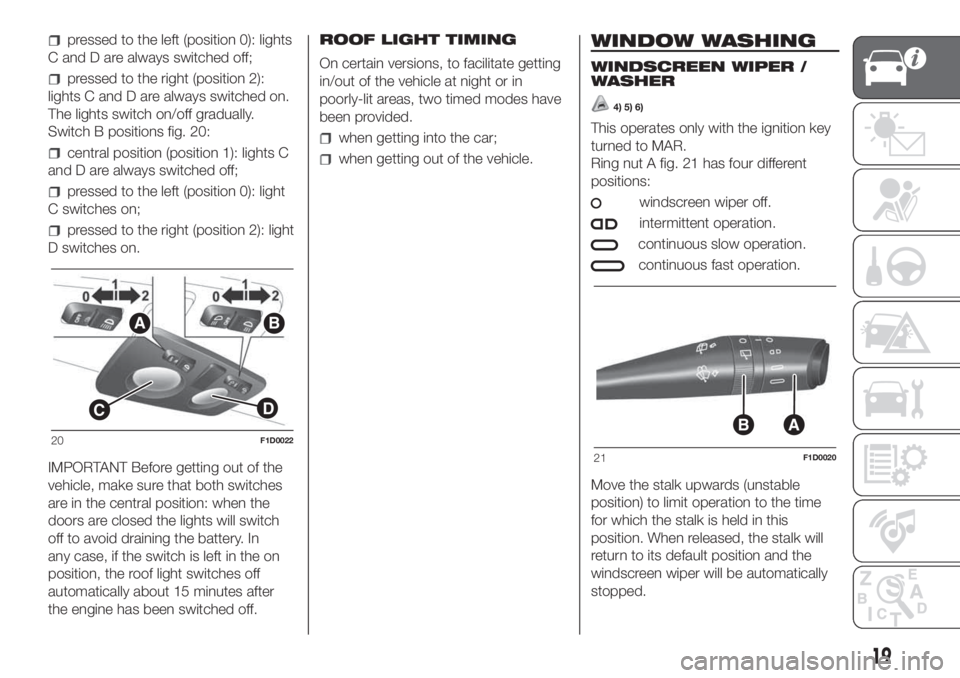
pressed to the left (position 0): lights
C and D are always switched off;
pressed to the right (position 2):
lights C and D are always switched on.
The lights switch on/off gradually.
Switch B positions fig. 20:
central position (position 1): lights C
and D are always switched off;
pressed to the left (position 0): light
C switches on;
pressed to the right (position 2): light
D switches on.
IMPORTANT Before getting out of the
vehicle, make sure that both switches
are in the central position: when the
doors are closed the lights will switch
off to avoid draining the battery. In
any case, if the switch is left in the on
position, the roof light switches off
automatically about 15 minutes after
the engine has been switched off.ROOF LIGHT TIMING
On certain versions, to facilitate getting
in/out of the vehicle at night or in
poorly-lit areas, two timed modes have
been provided.
when getting into the car;
when getting out of the vehicle.
WINDOW WASHING
WINDSCREEN WIPER /
WASHER
4) 5) 6)
This operates only with the ignition key
turned to MAR.
Ring nut A fig. 21 has four different
positions:
windscreen wiper off.
intermittent operation.
continuous slow operation.
continuous fast operation.
Move the stalk upwards (unstable
position) to limit operation to the time
for which the stalk is held in this
position. When released, the stalk will
return to its default position and the
windscreen wiper will be automatically
stopped.
C
AB
D
20F1D0022BA
21F1D0020
19
Page 22 of 228
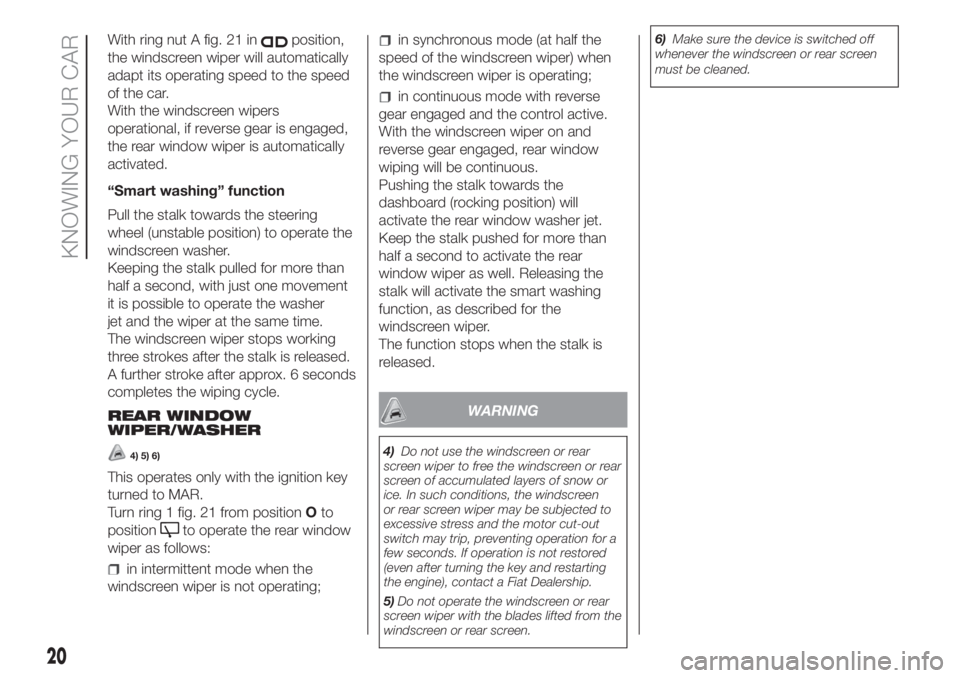
With ring nut A fig. 21 inposition,
the windscreen wiper will automatically
adapt its operating speed to the speed
of the car.
With the windscreen wipers
operational, if reverse gear is engaged,
the rear window wiper is automatically
activated.
“Smart washing” function
Pull the stalk towards the steering
wheel (unstable position) to operate the
windscreen washer.
Keeping the stalk pulled for more than
half a second, with just one movement
it is possible to operate the washer
jet and the wiper at the same time.
The windscreen wiper stops working
three strokes after the stalk is released.
A further stroke after approx. 6 seconds
completes the wiping cycle.
REAR WINDOW
WIPER/WASHER
4) 5) 6)
This operates only with the ignition key
turned to MAR.
Turn ring 1 fig. 21 from positionOto
position
to operate the rear window
wiper as follows:
in intermittent mode when the
windscreen wiper is not operating;
in synchronous mode (at half the
speed of the windscreen wiper) when
the windscreen wiper is operating;
in continuous mode with reverse
gear engaged and the control active.
With the windscreen wiper on and
reverse gear engaged, rear window
wiping will be continuous.
Pushing the stalk towards the
dashboard (rocking position) will
activate the rear window washer jet.
Keep the stalk pushed for more than
half a second to activate the rear
window wiper as well. Releasing the
stalk will activate the smart washing
function, as described for the
windscreen wiper.
The function stops when the stalk is
released.
WARNING
4)Do not use the windscreen or rear
screen wiper to free the windscreen or rear
screen of accumulated layers of snow or
ice. In such conditions, the windscreen
or rear screen wiper may be subjected to
excessive stress and the motor cut-out
switch may trip, preventing operation for a
few seconds. If operation is not restored
(even after turning the key and restarting
the engine), contact a Fiat Dealership.
5)Do not operate the windscreen or rear
screen wiper with the blades lifted from the
windscreen or rear screen.6)Make sure the device is switched off
whenever the windscreen or rear screen
must be cleaned.
20
KNOWING YOUR CAR
Page 23 of 228
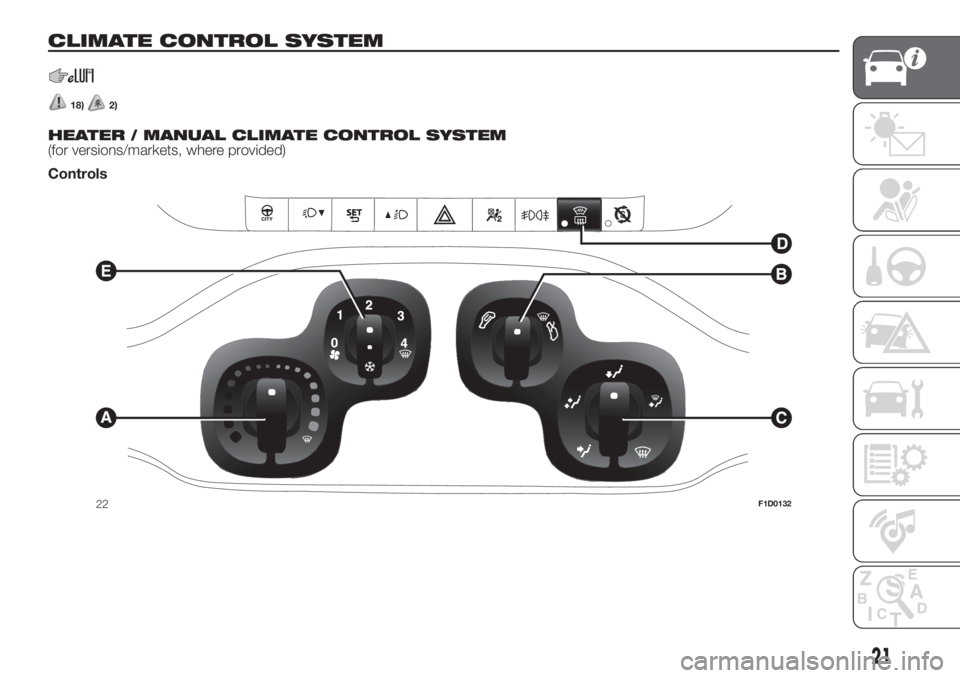
CLIMATE CONTROL SYSTEM.
18)2).
HEATER / MANUAL CLIMATE CONTROL SYSTEM
(for versions/markets, where provided)
Controls
1
02
3
4
22F1D0132
21
Page 24 of 228
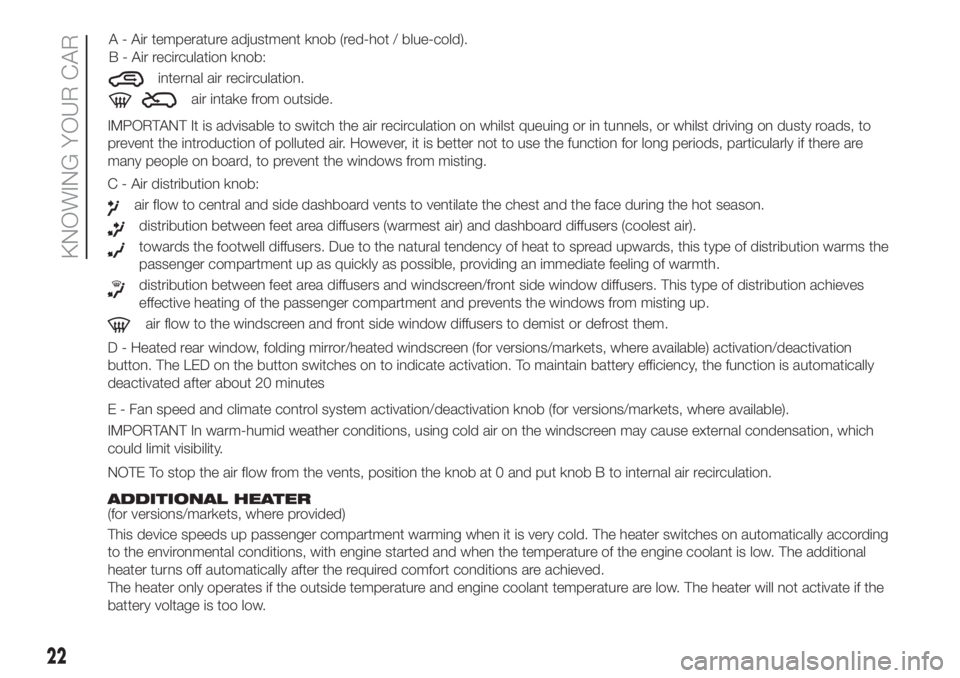
IMPORTANT It is advisable to switch the air recirculation on whilst queuing or in tunnels, or whilst driving on dusty roads, to
prevent the introduction of polluted air. However, it is better not to use the function for long periods, particularly if there are
many people on board, to prevent the windows from misting.
C - Air distribution knob:
air flow to central and side dashboard vents to ventilate the chest and the face during the hot season.
distribution between feet area diffusers (warmest air) and dashboard diffusers (coolest air).
towards the footwell diffusers. Due to the natural tendency of heat to spread upwards, this type of distribution warms the
passenger compartment up as quickly as possible, providing an immediate feeling of warmth.
distribution between feet area diffusers and windscreen/front side window diffusers. This type of distribution achieves
effective heating of the passenger compartment and prevents the windows from misting up.
air flow to the windscreen and front side window diffusers to demist or defrost them.
D - Heated rear window, folding mirror/heated windscreen (for versions/markets, where available) activation/deactivation
button. The LED on the button switches on to indicate activation. To maintain battery efficiency, the function is automatically
deactivated after about 20 minutes
E - Fan speed and climate control system activation/deactivation knob (for versions/markets, where available).
IMPORTANT In warm-humid weather conditions, using cold air on the windscreen may cause external condensation, which
could limit visibility.
NOTE To stop the air flow from the vents, position the knob at 0 and put knob B to internal air recirculation.
.
ADDITIONAL HEATER
(for versions/markets, where provided)
This device speeds up passenger compartment warming when it is very cold. The heater switches on automatically according
to the environmental conditions, with engine started and when the temperature of the engine coolant is low. The additional
heater turns off automatically after the required comfort conditions are achieved.
The heater only operates if the outside temperature and engine coolant temperature are low. The heater will not activate if the
battery voltage is too low.
22
KNOWING YOUR CAR
A - Air temperature adjustment knob (red-hot / blue-cold).
B - Air recirculation knob:
internal air recirculation.
air intake from outside.
Page 25 of 228
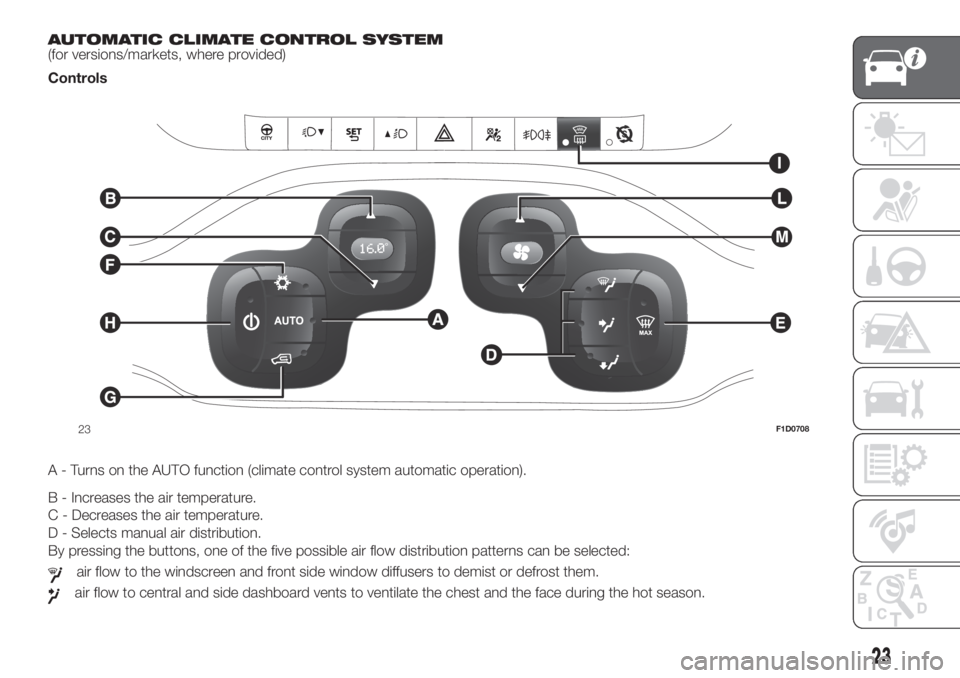
AUTOMATIC CLIMATE CONTROL SYSTEM
(for versions/markets, where provided)
Controls
.
A - Turns on the AUTO function (climate control system automatic operation).
B - Increases the air temperature.
C - Decreases the air temperature.
D - Selects manual air distribution.
By pressing the buttons, one of the five possible air flow distribution patterns can be selected:
air flow to the windscreen and front side window diffusers to demist or defrost them.
air flow to central and side dashboard vents to ventilate the chest and the face during the hot season.
23F1D0708
23
Page 26 of 228
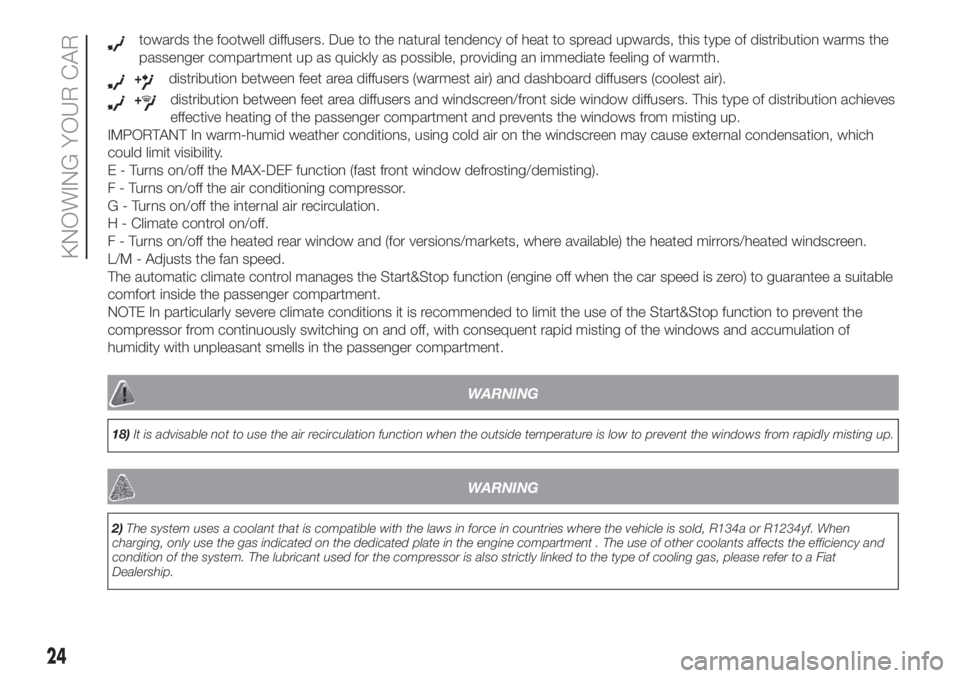
towards the footwell diffusers. Due to the natural tendency of heat to spread upwards, this type of distribution warms the
passenger compartment up as quickly as possible, providing an immediate feeling of warmth.
+distribution between feet area diffusers (warmest air) and dashboard diffusers (coolest air).
+distribution between feet area diffusers and windscreen/front side window diffusers. This type of distribution achieves
effective heating of the passenger compartment and prevents the windows from misting up.
IMPORTANT In warm-humid weather conditions, using cold air on the windscreen may cause external condensation, which
could limit visibility.
E - Turns on/off the MAX-DEF function (fast front window defrosting/demisting).
F - Turns on/off the air conditioning compressor.
G - Turns on/off the internal air recirculation.
H - Climate control on/off.
F - Turns on/off the heated rear window and (for versions/markets, where available) the heated mirrors/heated windscreen.
L/M - Adjusts the fan speed.
The automatic climate control manages the Start&Stop function (engine off when the car speed is zero) to guarantee a suitable
comfort inside the passenger compartment.
NOTE In particularly severe climate conditions it is recommended to limit the use of the Start&Stop function to prevent the
compressor from continuously switching on and off, with consequent rapid misting of the windows and accumulation of
humidity with unpleasant smells in the passenger compartment.
.
WARNING
18)It is advisable not to use the air recirculation function when the outside temperature is low to prevent the windows from rapidly misting up.
WARNING
2)The system uses a coolant that is compatible with the laws in force in countries where the vehicle is sold, R134a or R1234yf. When
charging, only use the gas indicated on the dedicated plate in the engine compartment . The use of other coolants affects the efficiency and
condition of the system. The lubricant used for the compressor is also strictly linked to the type of cooling gas, please refer to a Fiat
Dealership.
24
KNOWING YOUR CAR
Page 27 of 228
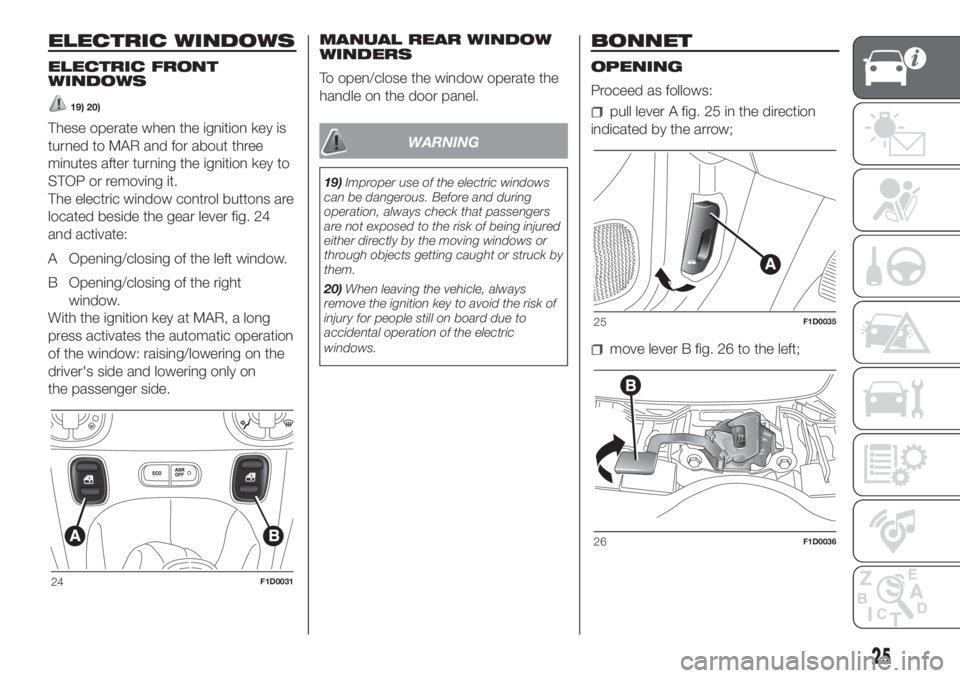
ELECTRIC WINDOWS
ELECTRIC FRONT
WINDOWS
19) 20)
These operate when the ignition key is
turned to MAR and for about three
minutes after turning the ignition key to
STOP or removing it.
The electric window control buttons are
located beside the gear lever fig. 24
and activate:
A Opening/closing of the left window.
B Opening/closing of the right
window.
With the ignition key at MAR, a long
press activates the automatic operation
of the window: raising/lowering on the
driver's side and lowering only on
the passenger side.MANUAL REAR WINDOW
WINDERS
To open/close the window operate the
handle on the door panel.WARNING
19)Improper use of the electric windows
can be dangerous. Before and during
operation, always check that passengers
are not exposed to the risk of being injured
either directly by the moving windows or
through objects getting caught or struck by
them.
20)When leaving the vehicle, always
remove the ignition key to avoid the risk of
injury for people still on board due to
accidental operation of the electric
windows.
BONNET
OPENING
Proceed as follows:
pull lever A fig. 25 in the direction
indicated by the arrow;
move lever B fig. 26 to the left;
24F1D0031
25F1D0035
26F1D0036
25
Page 28 of 228
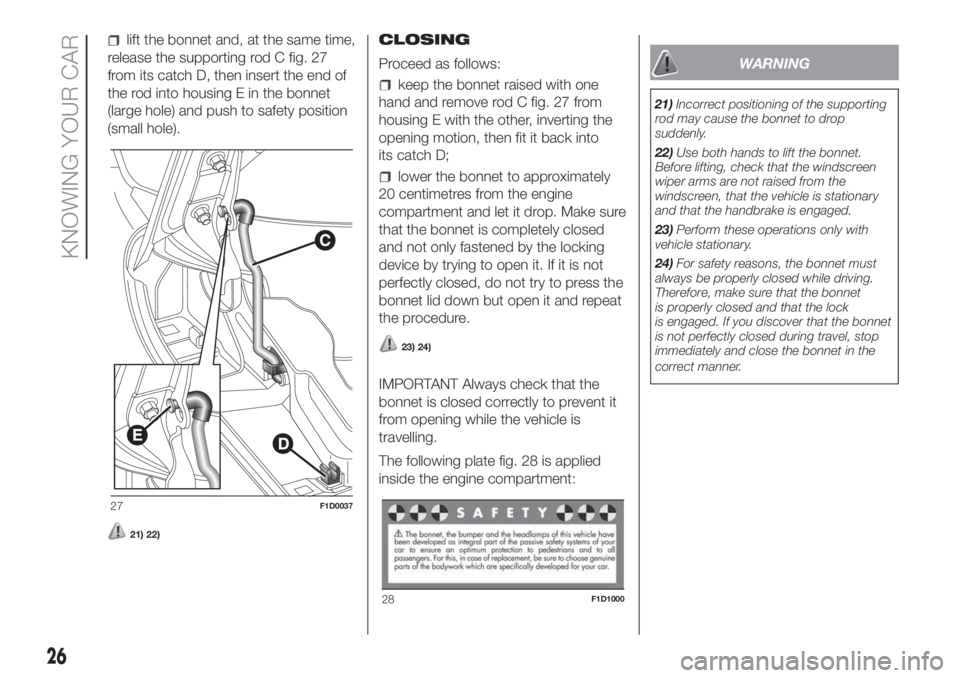
lift the bonnet and, at the same time,
release the supporting rod C fig. 27
from its catch D, then insert the end of
the rod into housing E in the bonnet
(large hole) and push to safety position
(small hole).
21) 22)
CLOSING
Proceed as follows:
keep the bonnet raised with one
hand and remove rod C fig. 27 from
housing E with the other, inverting the
opening motion, then fit it back into
its catch D;
lower the bonnet to approximately
20 centimetres from the engine
compartment and let it drop. Make sure
that the bonnet is completely closed
and not only fastened by the locking
device by trying to open it. If it is not
perfectly closed, do not try to press the
bonnet lid down but open it and repeat
the procedure.
23) 24)
IMPORTANT Always check that the
bonnet is closed correctly to prevent it
from opening while the vehicle is
travelling.
The following plate fig. 28 is applied
inside the engine compartment:
WARNING
21)Incorrect positioning of the supporting
rod may cause the bonnet to drop
suddenly.
22)Use both hands to lift the bonnet.
Before lifting, check that the windscreen
wiper arms are not raised from the
windscreen, that the vehicle is stationary
and that the handbrake is engaged.
23)Perform these operations only with
vehicle stationary.
24)For safety reasons, the bonnet must
always be properly closed while driving.
Therefore, make sure that the bonnet
is properly closed and that the lock
is engaged. If you discover that the bonnet
is not perfectly closed during travel, stop
immediately and close the bonnet in the
correct manner.
27F1D0037
28F1D1000
26
KNOWING YOUR CAR
Page 29 of 228
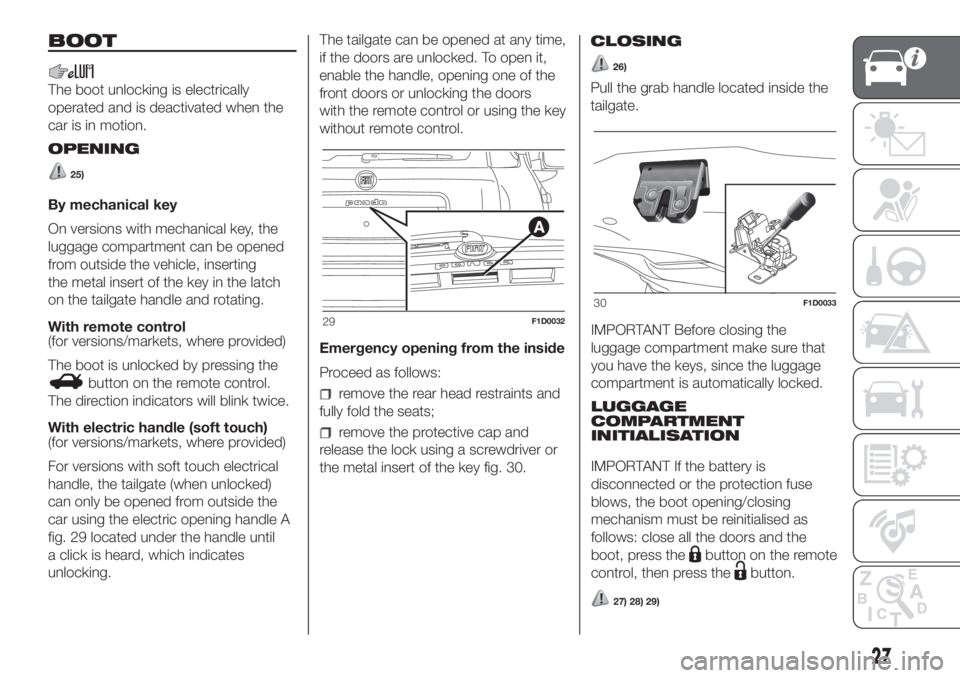
BOOT
The boot unlocking is electrically
operated and is deactivated when the
car is in motion.
OPENING
25)
By mechanical key
On versions with mechanical key, the
luggage compartment can be opened
from outside the vehicle, inserting
the metal insert of the key in the latch
on the tailgate handle and rotating.
With remote control
(for versions/markets, where provided)
The boot is unlocked by pressing the
button on the remote control.
The direction indicators will blink twice.
With electric handle (soft touch)
(for versions/markets, where provided)
For versions with soft touch electrical
handle, the tailgate (when unlocked)
can only be opened from outside the
car using the electric opening handle A
fig. 29 located under the handle until
a click is heard, which indicates
unlocking.The tailgate can be opened at any time,
if the doors are unlocked. To open it,
enable the handle, opening one of the
front doors or unlocking the doors
with the remote control or using the key
without remote control.
Emergency opening from the inside
Proceed as follows:remove the rear head restraints and
fully fold the seats;
remove the protective cap and
release the lock using a screwdriver or
the metal insert of the key fig. 30.CLOSING
26)
Pull the grab handle located inside the
tailgate.
IMPORTANT Before closing the
luggage compartment make sure that
you have the keys, since the luggage
compartment is automatically locked.
LUGGAGE
COMPARTMENT
INITIALISATION
IMPORTANT If the battery is
disconnected or the protection fuse
blows, the boot opening/closing
mechanism must be reinitialised as
follows: close all the doors and the
boot, press the
button on the remote
control, then press the
button.
27) 28) 29)
29F1D0032
30F1D0033
27
Page 30 of 228
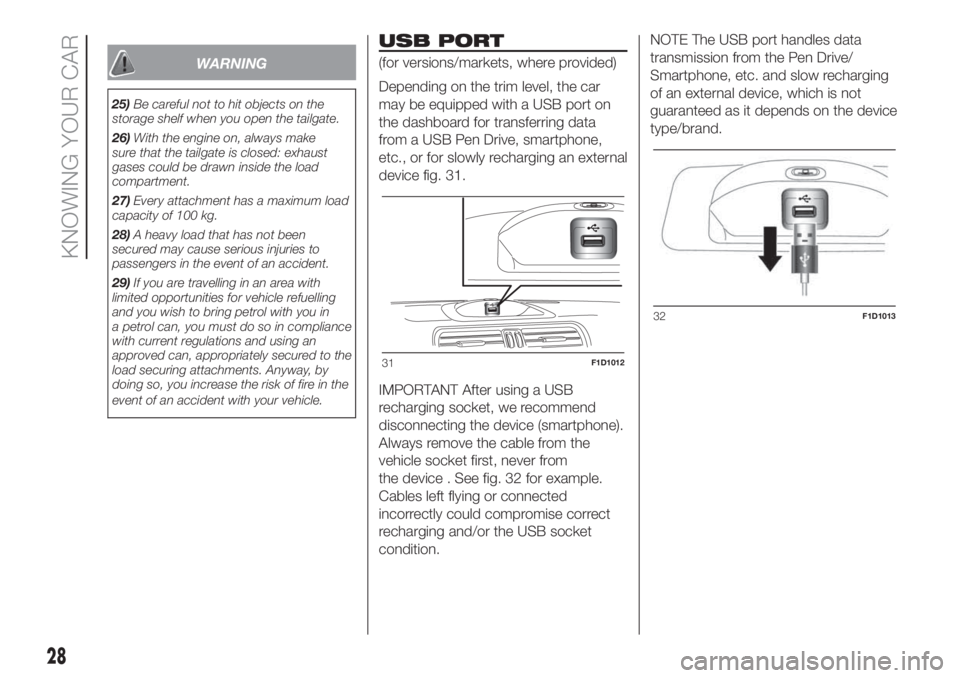
WARNING
25)Be careful not to hit objects on the
storage shelf when you open the tailgate.
26)With the engine on, always make
sure that the tailgate is closed: exhaust
gases could be drawn inside the load
compartment.
27)Every attachment has a maximum load
capacity of 100 kg.
28)A heavy load that has not been
secured may cause serious injuries to
passengers in the event of an accident.
29)If you are travelling in an area with
limited opportunities for vehicle refuelling
and you wish to bring petrol with you in
a petrol can, you must do so in compliance
with current regulations and using an
approved can, appropriately secured to the
load securing attachments. Anyway, by
doing so, you increase the risk of fire in the
event of an accident with your vehicle.
USB PORT
(for versions/markets, where provided)
Depending on the trim level, the car
may be equipped with a USB port on
the dashboard for transferring data
from a USB Pen Drive, smartphone,
etc., or for slowly recharging an external
device fig. 31.
IMPORTANT After using a USB
recharging socket, we recommend
disconnecting the device (smartphone).
Always remove the cable from the
vehicle socket first, never from
the device . See fig. 32 for example.
Cables left flying or connected
incorrectly could compromise correct
recharging and/or the USB socket
condition.NOTE The USB port handles data
transmission from the Pen Drive/
Smartphone, etc. and slow recharging
of an external device, which is not
guaranteed as it depends on the device
type/brand.
31F1D1012
32F1D1013
28
KNOWING YOUR CAR